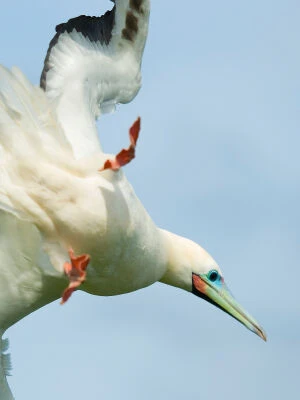Seabirds, Forest Birds and Waterbirds Abound on the Garden Island
Bird lovers love Kauai due to the great variety of birds that can be seen on the Garden Island. Many of these bird species are rare and endangered, and found nowhere else on Earth.
Kilauea Wildlife Refuge

Red footed booby.
Located on the northernmost point of the main Hawaiian Islands, this protected refuge area is the nesting area of many native Hawaiian bird species from large albatross doing their courtship dances to red-footed boobies nesting on the steep cliffs facing the peninsula bluff atop which sits the historic Lighthouse. Iwa (Great Frigatebirds) and Tropicbirds are often seen flying high above, while shearwaters nest in burrows on the ground.
Forest Birds
To see some of the planet’s rarest forest birds head up to Kokee State Park on Kauai’s west side. Hiking along the Pihea trail through the Alakai Swamp you can keep an eye out for the crimson colored iiwi bird. The elepaio is best identified by its voluminous whistle that sounds like “el-e-pai-o.” There are dozens of miles of hiking trails in the park to explore and potentially see rare Hawaiian forest birds. Stop in at the Kokee Natural History Museum to learn about the local flora and fauna.
Water Birds

Black crowned night heron.
To see some rare waterbirds head to the Hanalei Wildlife Refuge near Hanalei Bridge. On the grassy areas between the taro patches and along the riverbank you will often see the nene, or Hawaiian goose, which is Hawaii’s state bird. They get their name from the “ney, ney” sounds they make. Also near the river you will see black-crowned night heron, white coots, moorhens and stilts are seen in the taro patches along with koloa ducks.

Black necked stilt.
The Hawaiian black-necked stilt is easy to spot with its long pink legs perfect for wading through the taro ponds. Listen for their “keek, keek” chirping sounds as you watch them poke their beaks down into the water to catch food.
The Hawaiian moorhen (alae ula) can be identified by its bright red forehead. Moorhens are fairly big at about 13 inches long, as are coots which look similar to moorhen except they have a white forehead. The moorhen also has a red bill with a tip that is yellow to very light green.
The Hawaiian coots like to build floating nests that move up and down with the changing water levels of the taro patches. Their Hawaiian name alae keoke refers to their distinctive ivory white frontal shield (keoke means white).
Another rare bird that inhabits the Hanalei Wildlife Refuge is koloa maoli, the Hawaiian duck. About 18 inches long, koloa are mottled brown in color with orange feet and legs, and a greenish head. Some of the male koloa have a spot of orange at the tip of their bill.